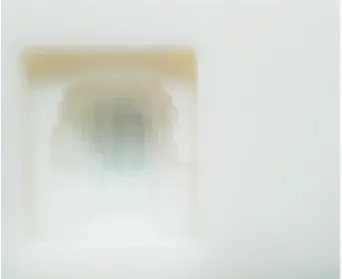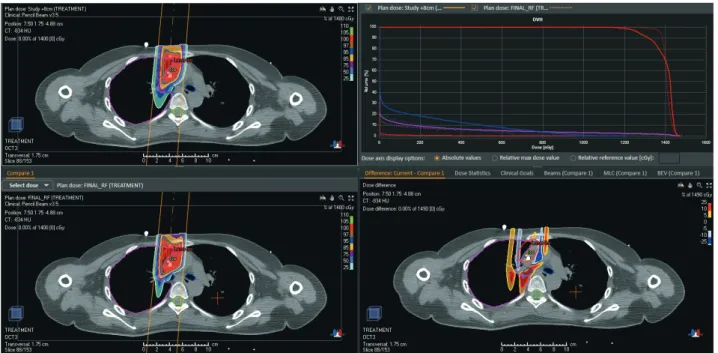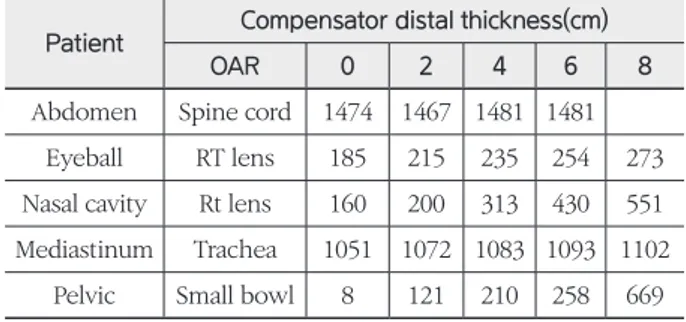서 론
양성자 치료는 기존 광자선과는 다르게 인체를 통과 하는 도중에는 방사선을 방출하지 않고 Range가 끝나
는 곳에서 방출하는 특징이 있다. 이를 브래그 피크(Braff peak)라 하며 종양조직의 앞쪽이나 뒤쪽의 정상조직에는 불필요한 손상을 최소화하며 종양조직에 고선량의 방사선 을 조사하는 큰 장점이 있다. 하지만 양성자치료의 이러한 특성은 치료 시 환자 Setup에 따른 변화가 심하며, 급격한 선량분포로 인해 조금의 위치변화에 따라 선량분포가 틀 려져 Target volume에 원하는 선량이 들어가지 않을 수
책임저자: 장준영, 삼성서울병원 서울 강남구 일원로 81 Tel: 02)6190-5326
E-mail: jy938.jang@samsung.com
양성자 치료 시 사용되는 Compensator의 Thickness에 대한 적정성 평가
삼성서울병원 방사선종양학과 박용수·장준영·조광현·박용철·최병기
목 적 : 본원에서 사용하는 양성자 에너지는 크기에 따라 도달거리가 달라지며, Compensator는 Distal 두께 에 따라 Energy의 크기를 다르게 할 수 있으며 이로 인해 Dose rate이 변화된다. 따라서 Compensator dis- tal의 두께를 변화시키면서 Dose 분포 및 Beam on time에 대한 영향을 평가해보고자 한다
대상 및 방법 : 본원에서 양성자치료를 받은 에너지가 낮은 환자 5명을 대상으로 실험하였다. 선택된 환자들 의 기존 치료 시 Beam on time을 확인하였으며 이 후 양성자치료계획시스템(TPS)을 통하여 Compensator 의 Distal 두께를 기존 두께에서 2 cm씩 최대 14 cm까지 증가시켜가며 치료계획을 비교 평가하였다. Dose 분포를 평가하기 위하여 Target의 Conformity Index(CI)값과 Homogeneity Index(HI)값, Target 후면부의 Organ at risk(OAR)의 최대선량을 비교하였으며 치료시간에 대한 영향을 평가하고자 Compensator Distal 두께 별로 제작하여 Beam on time을 비교하여 평가하였다.
결 과 : Compensator의 Distal 두께를 증가시켜 Homogeneity Index, Conformity Index를 분석한 결과 모 든 환자에서 동일한 수치가 나왔다. Target 후면부의 OAR을 비교한 결과 Abdomen의 Spine cord에 최대 7 cGy, Eyeball의 RT Lens에서 88 cGy, Nasal cavity의 RT Lens에 391 cGy, Mediastinum의 Trachea에 51 cGy, Pelvis의 Small bowl에 661 cGy 증가하였다. Beam on time을 비교한 결과 Abdomen의 경우 기존 126초에서 최대 62초, Eyeball의 경우 105초에서 37초, Nasal cavity의 경우 기존 187초에서 134초, Medi- astinum의 경우 기존 100초에서 40초, Pelvis의 경우 기존 440초에서 118초로 감소하였다.
결 론 : 연구결과 Compensator의 distal 두께가 두꺼워질수록 에너지의 크기를 증가시킬 수 있으며 Dose rate이 증가하여 Beam on time이 감소하는 효과가 있었다. 이는 Beam on time이 많이 소요되는 호흡동조 치료를 요하는 Liver, 마취를 하는 소아환자에게 적용한다면 치료시간 단축과 환자의 편의성 면에서 큰 도움을 줄 것으로 평가된다. 하지만 에너지의 크기가 증가할수록 Distal penumbra가 증가하기 때문에 Target 후면부 에 OAR이 인접해 있는 경우는 양성자치료계획 시 Penumbra의 영향을 고려한 적절한 Compensator 두께 를 설정할 필요가 있을 것으로 사료된다.
▶ 핵심용어 : Compensator, Distal thickness, Beam on time, Energy, Dose rate
있으며, 주변 정상 조직에 불필요한 선량이 전달될 수 있다.
따라서 양성자 치료 시 정확하고 균일한 Target의 선량전 달을 위해 compensator를 사용한다.
현재 본원의 양성자 wobbling 치료 시 사용하는 Compensator는 Target의 Distal Margin 대해 양성자 빔 선량을 보정하는 역할을 하며 양성자 빔의 종축방향에서
의 Target의 3차원적인 모양으로 정확하게 분포되도록 하 는 역할을 한다. 이러한 Compensator는 distal 두께에 따 라 양성자 조사 시 Energy의 크기를 다르게 할 수 있으 며 이로 인해 Dose rate이 변화된다. 현재 양성자치료계 획시스템(TPS)의 Compensator의 distal 두께는 최소값 으로 설정되어 있으며 이로 인해 Dose rate이 낮게 설정 되어지는데 이는 치료 중 환자의 재현성 유지의 어려움 및 Intrafraction motion error를 발생시킬 수 있으며 치료의 효율성 또한 떨어지게 할 수 있다. 따라서 Compensator distal 두께를 변화시키면서 선량분포 및 beam on time 에 대한 영향을 평가해 보고자 한다.
대상 및 방법
1. 실험재료
- Proton therapy(SHI, JAPAN) - Ray station 5.1(RaySearch, USA) - IEC Body water phantom(NEMA, USA) - Robo-drill(Fanuc, lnc, Korea)
- Green shot BS(SHI, JAPAN) Fig. 1. Compensator
Fig. 2. Compensator and distal thickness
Table 1. Patient
Patient Site Thickness (cm)
Energy (Mev)
Dose rate
1 Abdomen 6 135 1.3
2 Eyeball 6 104.4 0.5
3 Nasal cavity 6 70 0.2
4 Mediastinum 6 97.2 0.4
5 Spine 6 94.4 0.4
Table 2. Beam on time
Patient Site Beam on time(Sec)
Energy (Mev)
Dose rate
1 Abdomen 126 135 1.3
2 Eyeball 105 104.4 0.5
3 Nasal cavity 187 70 0.2
4 Mediastinum 100 97.2 0.4
5 Spine 440 94.4 0.4
2. 실험 방법
1) Planning
본원에서 치료받은 5명의 저에너지에 Compensator distal 두께가 6 cm인 환자를 선정(Table 1)하고 SHI사의 Green shot BS(beam time check program)을 이용하 여 실제 Beam on time을 구하였다(Table 2). Ray station 5.0(RaySearch, USA)을 이용하여 기존에 치료계획되어 있는 5명의 환자 Plan에서 다른 항목의 변화 없이 Com- pensator의 두께를 2 cm씩 증가시켜가며 새로운 Plan 을 진행하였다. 또한 CTV 내의 선량분포를 평가하기 위해 Homogeneity Index(HI), Conformity Index(CI) 평가 지표로 설정하였으며 Target 후면부 Organ At Risk(OAR)
에 들어가는 최대선량을 확인하여 기존 Plan과 비교 및 분 석하였다. 그 후 Robo-drill(Fanuc, lnc, Korea)를 이용 하여 실제로 Compensator를 제작하였다.
2) Beam time checking
IEC water phantom(NEMA, USA)와 Proton therapy(SHI, JAPAN)장비를 이용하여 5명의 선택된 환 자의 Beam on time을 측정하였다. 기존 Plan에 적용되 어 있는 모든 조건은 동일하게 설정되었으며 새로 제작한 Compensator를 이용하여 측정하였다. 측정된 Beam on time과 기존의 Beam on time을 비교하여 실제로 치료시 간이 얼마나 단축되는지를 확인하였다.
Fig. 3. Comparison existing plan and new plan
Fig. 4. New compensator that increasing compensator
distal thickness Fig. 5. Comparison beam on time existing plan and new plan
결 과
1. Planning
5명의 저에너지의 환자에서 Compensator을 2 cm씩 변 화시킨 결과 CTV에 대한 HI, CI는 각 환자에서 동일하게 나타났다(Table 3, 4). 또한 환자들의 총 치료횟수에 대한 후면부 OAR의 선량을 비교한 결과 Abdomen을 치료한 환자의 경우 spine에 들어가는 최대선량이 변화가 거의 없 었다(Table 5). Eyeball을 치료한 환자의 경우 RT Lens의 최대선량이 기존 Plan보다 각각 30 cGy, 50 cGy, 69 cGy, 88 cGy 증가하였다(Table 5). Nasal cavity를 치료한 환자 의 경우 RT Eyeball의 최대선량이 각각 100 cGy, 217 cGy, 347 cGy, 526 cGy 증가하였다(Table 5). Mediastinum 을 치료한 환자의 경우 Trachea에서의 최대선량이 각각 21 cGy, 32 cGy, 42 cGy, 51 cGy 증가하였다(Table 5). 마지막 으로 Pelvis를 치료한 환자의 Small bowel에서 각각 113 Gy, 202 cGy, 250 cGy, 661 cGy 증가하였다(Table 5).
2. Beam on time
2 cm씩 증가시킨 Compensator를 이용하여 Beam on time을 측정한 결과 기존 Compensator를 사용하여 측 정한 Beam on time보다 감소하였다. Abdomen을 치료 한 환자의 경우 Compensator를 2 cm씩 증가시킨 경우 기존 Beam on time 시간인 126초에서 각각 109초, 71초, 62초로 감소하였다. Eyeball을 치료한 환자의 경우 기존 Beam on time 120초에서 105초, 74초, 49초, 37초로 감 소하였다. Nasal cavity를 치료한 환자의 경우 기존 Beam on time 187초에서 187초, 175초, 134초, 64초로 감소하 였다. Mediastinum을 치료한 환자의 경우 기존 Beam on time 105초에서 100초, 77초, 58초, 40초로 감소하였다.
마지막으로 Pelvis를 치료한 환자의 경우 기존 Beam on time 440초에서 412초, 262초, 168초, 118초로 감소하였 다(Table 6).
Table 3. Homogeneity Index
Patient Compensator distal Thickness(cm)
0 2 4 6 8
Abdomen 1.3327 1.3327 1.3327 1.3327 1.3327 Eyeball 18.553 18.553 18.553 18.553 18.553
Nasal cavity
Mediastinum 1.362 1.362 1.362 1.362 1.362 Pelvis 1.5077 1.5077 1.5077 1.5077 1.5077
Table 4. Conformity Index
Patient Compensator distal Thickness(cm)
0 2 4 6 8
Abdomen 7.1157 7.1157 7.1157 7.1157 7.1157 Eyeball 4.9187 4.9187 4.9187 4.9187 4.9187
Nasal cavity
Mediastinum 2.335 2.335 2.335 2.335 2.335 Pelvis 4.0394 4.0394 4.0394 4.0394 4.0394
Table 5. OAR dose
Patient Compensator distal thickness(cm)
OAR 0 2 4 6 8
Abdomen Spine cord 1474 1467 1481 1481 Eyeball RT lens 185 215 235 254 273 Nasal cavity Rt lens 160 200 313 430 551 Mediastinum Trachea 1051 1072 1083 1093 1102
Pelvic Small bowl 8 121 210 258 669
Table 6. Beam on time
Patient Compensator distal Thickness(cm)
Beam on time
0 2 4 6 8
Abdomen 126 109 71 62
Eyeball 120 105 74 49 37
Nasal cavity 187 187 175 134 64
Mediastinum 105 100 77 58 40
Pelvis 440 412 262 168 118
결론 및 고찰
현재 본원의 양성자 치료에 사용되는 Compensator 에 대해 기존 Compensator에서 2 cm씩 증가시켰을 때 HI값, CI값은 기존과 동일하였으며, 에너지 증가에 따라 Dose rate을 증가시켜 환자 치료 시 소요되는 Beam on time을 감소시킬 수 있었다. 이는 양성자 Wobbling 치료 시 Compensator를 증가시켜 치료 시간을 감소시킴으로 써 환자에게 발생하는 Intrafraction motion error를 줄 일 수 있다는 것을 의미한다. 또한 Energy 증가에 따른 Dose rate 증가에 Biological한 영향은 Proton 치료에서 는 고려하지 않아도 된다는 결과가 나와 있다(Ref 4). 하지 만 Compensator를 증가시킬 때 Dose rate이 증가함에 따라 Fall off 구간에서 Distal penumbra가 커지게 되어 Target 후면부 OAR에 들어가는 최대 선량이 증가하였다.
따라서 Compensator를 증가시켜 Beam on time을 줄 일 시, Compensator 증가와 더불어 생기는 Penumbra를 평가하여 적절한 Compensator 두께를 선정해야 할 것이 다. 또한 치료 시간이 오래 걸리며 호흡동조치료를 요하는 Liver, 마취를 하는 소아환자에게 Compensator의 두께 를 늘려 적용한다면 치료시간 단축과 환자의 편의성 면에 서 큰 도움을 줄 것으로 사료된다.
하지만 이 실험은 초기 Plan시 Compensator를 증가시 키지 않고 완성된 Plan에 대한 Compensator 두께 증가를 평가하였다는 한계점이 있었다. 처음 Compensator 증가 시킨 후 그에 따른 적절한 Plan을 진행한다면 Penumbra 에 의한 선량증가를 줄일 수 있을 것이라 사료된다
참고문헌
1. Kim Tae Woan, Kim Dae Woong, Kim Jae Weon, Jeong Kyeong Sik: Dose comparison according to Smooth Thickness application of Range compensa- tor during proton therapy for brain tumor patient, The Journal of Korean Society for Radiation Therapy v.28 no.2, 2016, pp.139-148
2. Taeko Matsuura, Yusuke Egashira, Teiji Nishio, Yo- shitaka Matsumoto, Mami Wada, Sachiko Koike, and Yoshiya Furusawa: Apparent absence of a pro- ton beam dose rate effect and possible differences in RBE between Bragg peak and plateau, Medical Physics, Vol. 37, No. 10, October 2010
3. Doo Young Sung, Seyjoon Park, Ji Hyun Park, Yong Chul Park, Hee Chul Park, Byoung Ki Choi: Com- paring the dosimetric impact of fiducial marker according to density override method : Planning study, The Journal of Korean Society for Radiation Therapy, Vol. 29 No.1 2017, pp. 19–26
4. Kim kwang suk, Jo kwang hyun, Choi byeong ki:
Dosimetric evaluation of using in-house BoS Frame Fixation Tool for the Head and Neck Cancer Patient, The Journal of Korean Society for Radiation Thera- py, Vol. 28 No. 1, 2016, pp. 35-46
Assessment of Compensator Thickness in Proton Therapy
Department of Radiation Oncology, Samsung Medical Center
Park Yong Soo, Jang Jun Yeong, Cho Gwang Hyeon, Park Yong Cheol, Choi Byeong Ki
Purpose : The range of force differs from the size of proton energy used in our hospital. The compensator en- ables to change energy size based on distal thickness which also makes changes in dose rate. Therefore, the purpose of this study is to evaluate the effect of changing the thickness of compensator distal on dose range and beam on time.
Subject and Methodology : Five low energy patients who have received proton therapy were selected as sub- jects for this study. Beam on was checked for the selected patients during the existing therapy. After then, the thickness of distal of compensator was increased by 2 cm up to 14 cm through proton therapy plan system(TPS) for comparative analysis. For the evaluation of dose range, the value of the target’s conformity index(CI) and the maximum dose of rear side target’s organ at risk(OAR) were compared. Furthermore, to evaluate the effect of therapy time, beam on time was compared by making compensator distal in each thickness.
Result : The result of homogeneity index and conformity index of the increased compensator distal showed the same level in all patients. The comparison results of OAR of target rear side showed 7 cGy at spine cord of abdomen at maximum, 88 cGy at eyeball’s RT lens, 391 cGy at RT lens of nasal cavity 51 cGy at trachea of the mediastinum, and 661 cGy at a small bowl of the pelvis. The comparison results of the beam on time showed a reduction from 126 seconds to 62 seconds for the abdomen, from 105 seconds to 37 seconds for the eyeball, from 187 seconds to 134 seconds for nasal cavity, from 100 seconds to 40 seconds for mediastinum, from 440 seconds to 118 seconds for the pelvis.
Conclusion : The research result showed that as the distal thickness of compensator increased, the size of energy increased. In addition, beam on decreased due to the increase of dose rate. It is expected that the result would help reduce the treatment time and increase the convenience of patients if it is applied to liver patients who need respiratorygated therapy and pediatric patients. However, distal penumbra increased as the size en- ergy increased. Therefore, in treating cases where OAR is in the vicinity of the target rear side, the influence of penumbra should be taken into account in adjusting thickness level of the compensator in proton therapy plan.
▶Keyword : Compensator, Distal thickness, Beam on time, Energy, Dose rate


